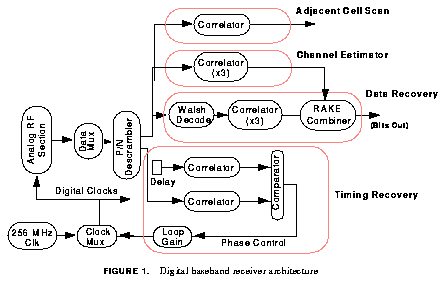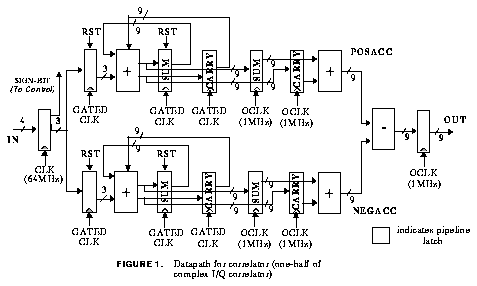
 |
JPL's Wireless Communication Reference WebsiteChapter:
Network Concepts and Standards
Section: Data and Multimedia Systems, Infopad,
Broadband CDMA Design,
Monolithic RF Circuitry
|

FIGURE: Digital baseband receiver architecture
P total = (CL · Vdd2·f clk)
CL is the effective loading capacitance, fclk is the clock frequency, and Vdd is the supply voltage. Thus, minimizing CL, Vdd and fclk, while retaining the required functionality becomes paramount. The reduction of Vdd is the key to low-power operation; however, a speed penalty is incurred by this, and must be compensated by architectural modifications in the system, by incorporating parallelism or pipelining. To optimize power, the supply voltage can be used as a design parameter. Three supply voltages are used: 1.5V, 3.3V, and 5V, with the multiple supply voltages being efficiently generated from a single battery using off-chip DC-DC converter circuitry. These voltages were chosen to match the supply voltages used by other chips in the mobile terminal (3.3V and 5V), plus a single "low-power" supply at 1.5V. The 1.5V figure has been shown to be the optimal supply voltage under certain assumptions. Likewise, level shifting buffers are used on- chip to interface between blocks at different supply voltages. Another technique used to optimize power was the choice of number representation. Since the sign of the data is constantly being toggled due to the multiplication with the Walsh and PN sequences, it was found that a sign-magnitude number representation will consume approximately 30% less power than a 2's complement number representation for this application.

FIGURE: Data path for correlator
Lastly, to be able to reduce the supply voltage down to 1.5V for the correlator datapaths, minimizing the critical path in the accumulator itself is mandatory. To achieve this, a carry- save adder architecture is employed; it effectively pipelines the adder at the per-bit level, reducing the critical path down to the delay through a single half-adder and a register. Each correlator thus can achieve the full 64 MHz throughput, running at a supply voltage of 1.5V, while only consuming 1.5 mW of power for each complex-valued correlator. To contrast, had a ripple-carry adder been employed in the accumulator, it would have needed to run at a 3.3V supply to meet the critical path (carry ripple through 9 bits), and power consumption per complex correlator would have increased almost fourfold, to 5 mW each.
Due to the fact that the clock generator needs to be able to adjust its phase very accurately (since it is being driven by the delay locked loop), it must run at 256 MHz, and consumes a significant fraction of the power since a supply voltage of 5V is needed. Otherwise, by minimizing the power consumed in the correlators, the total power consumption of the digital baseband receiver processing has been minimized to 27 mW, despite its extremely high operating frequencies.